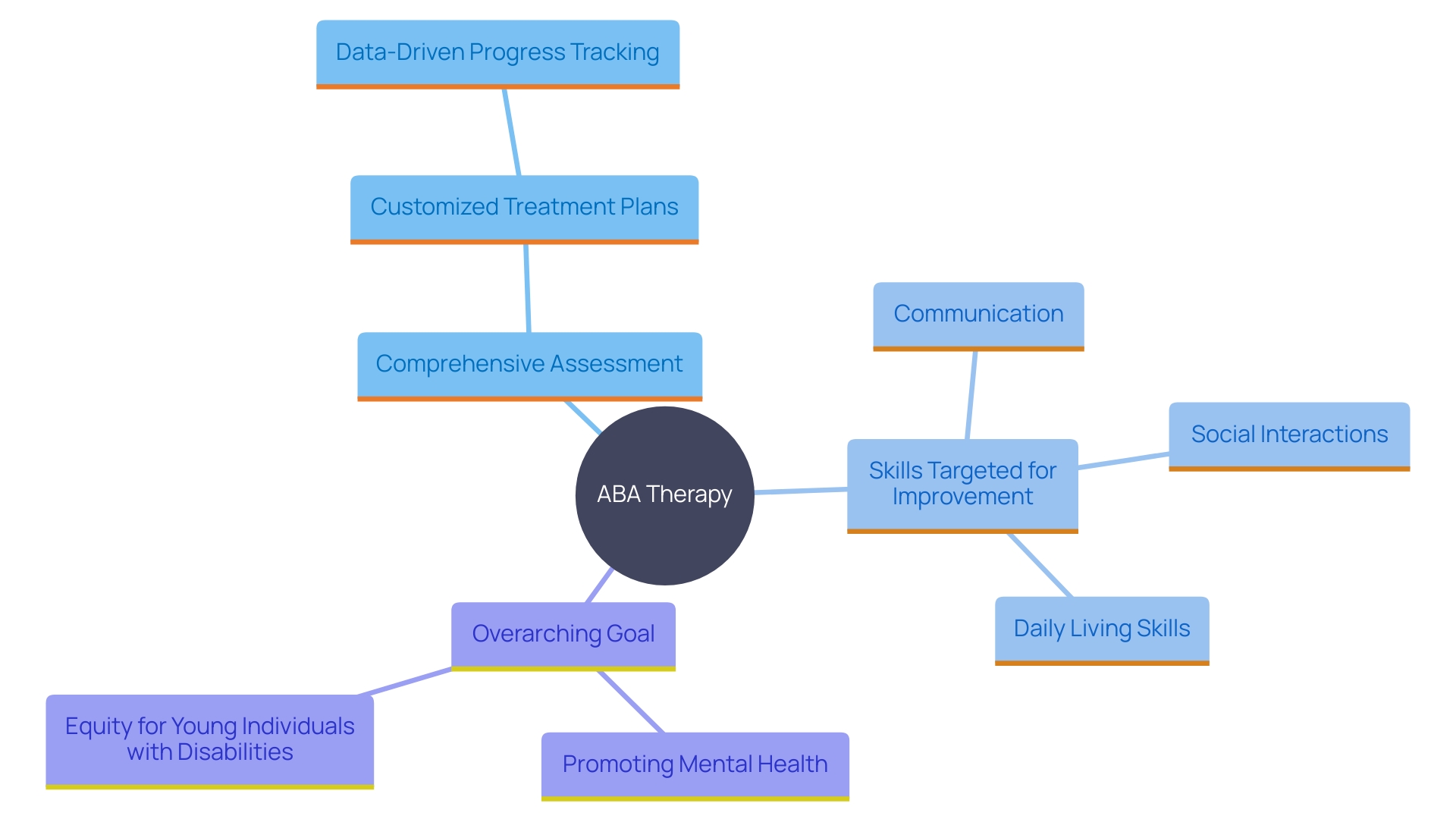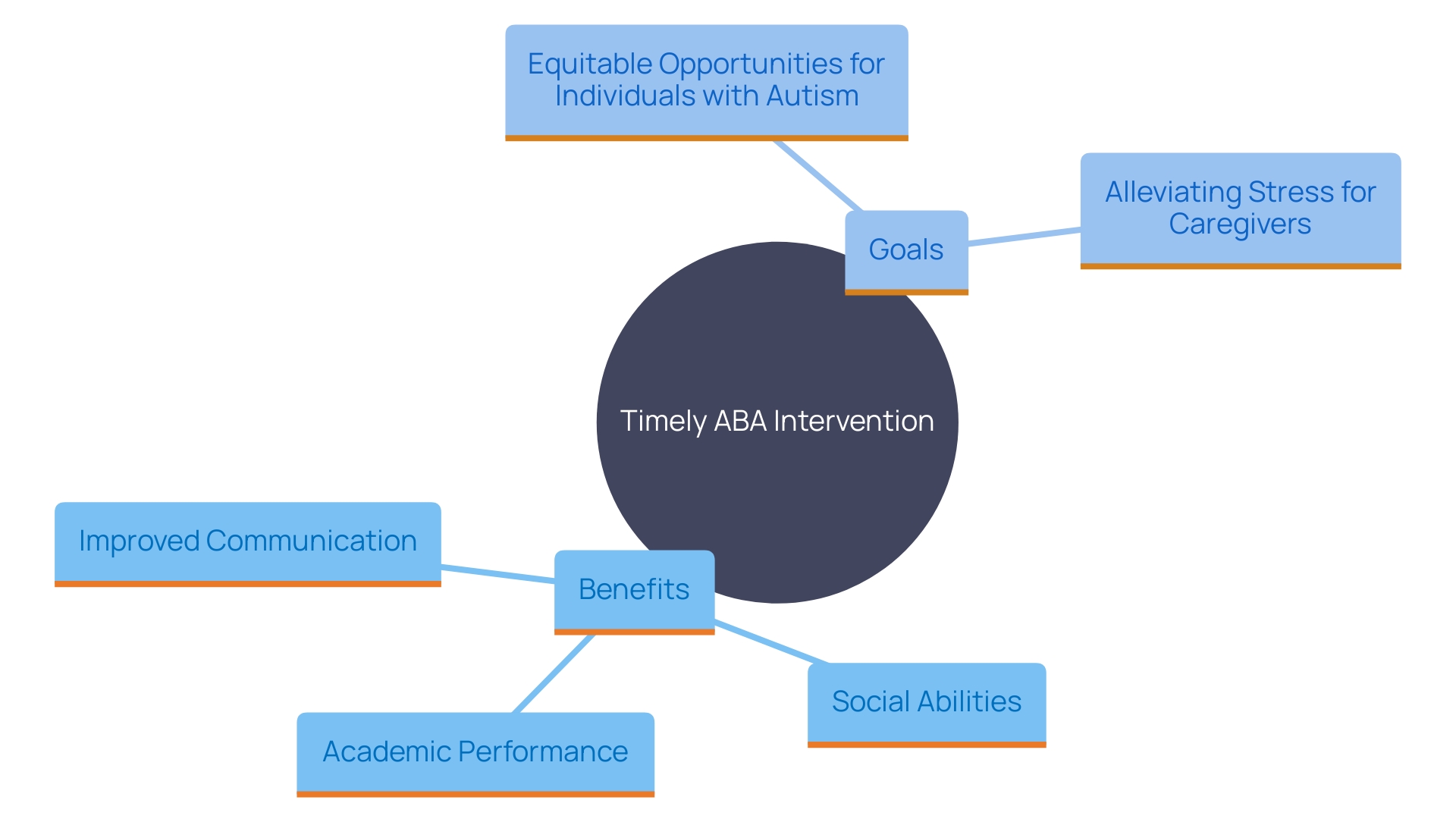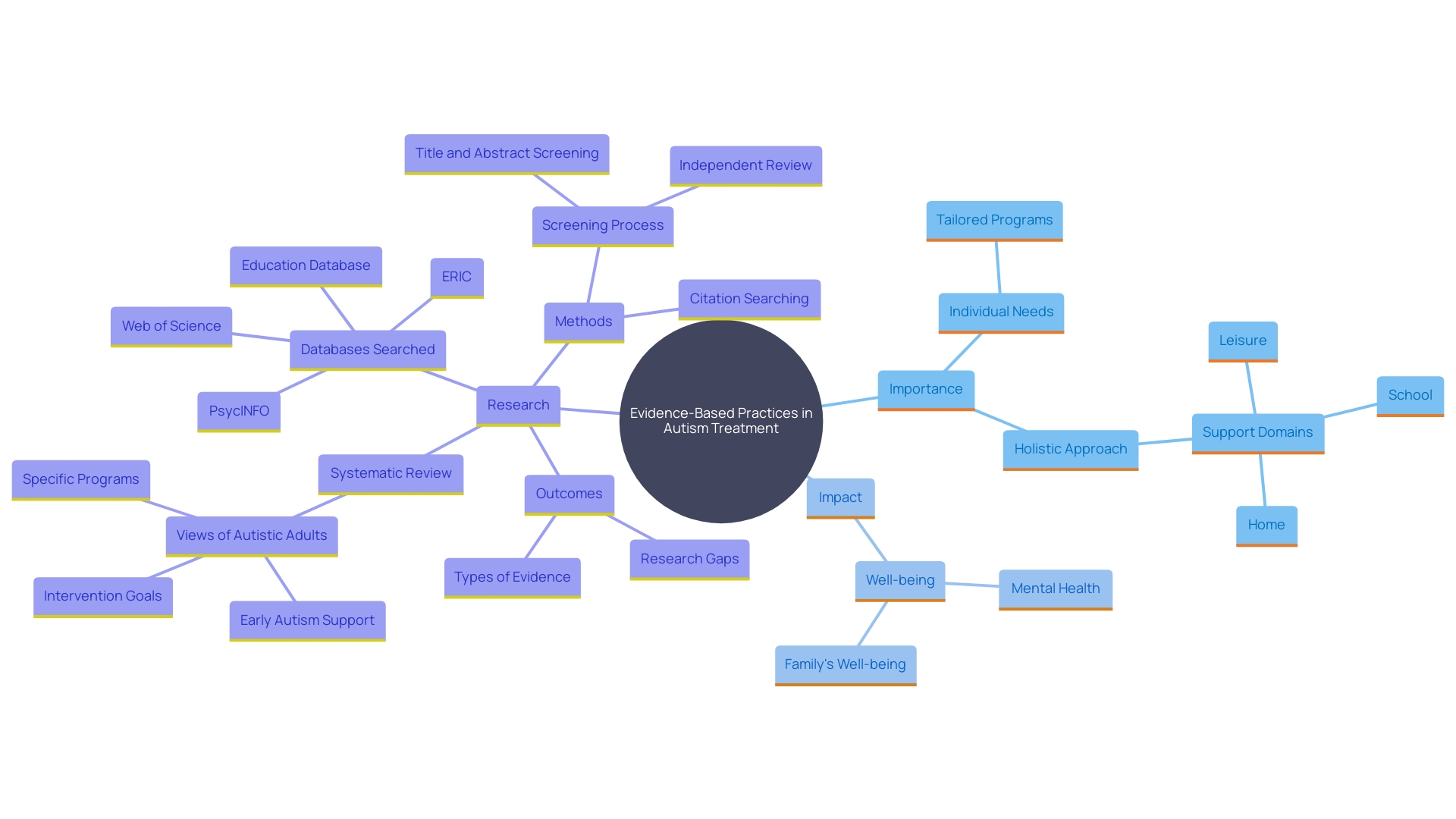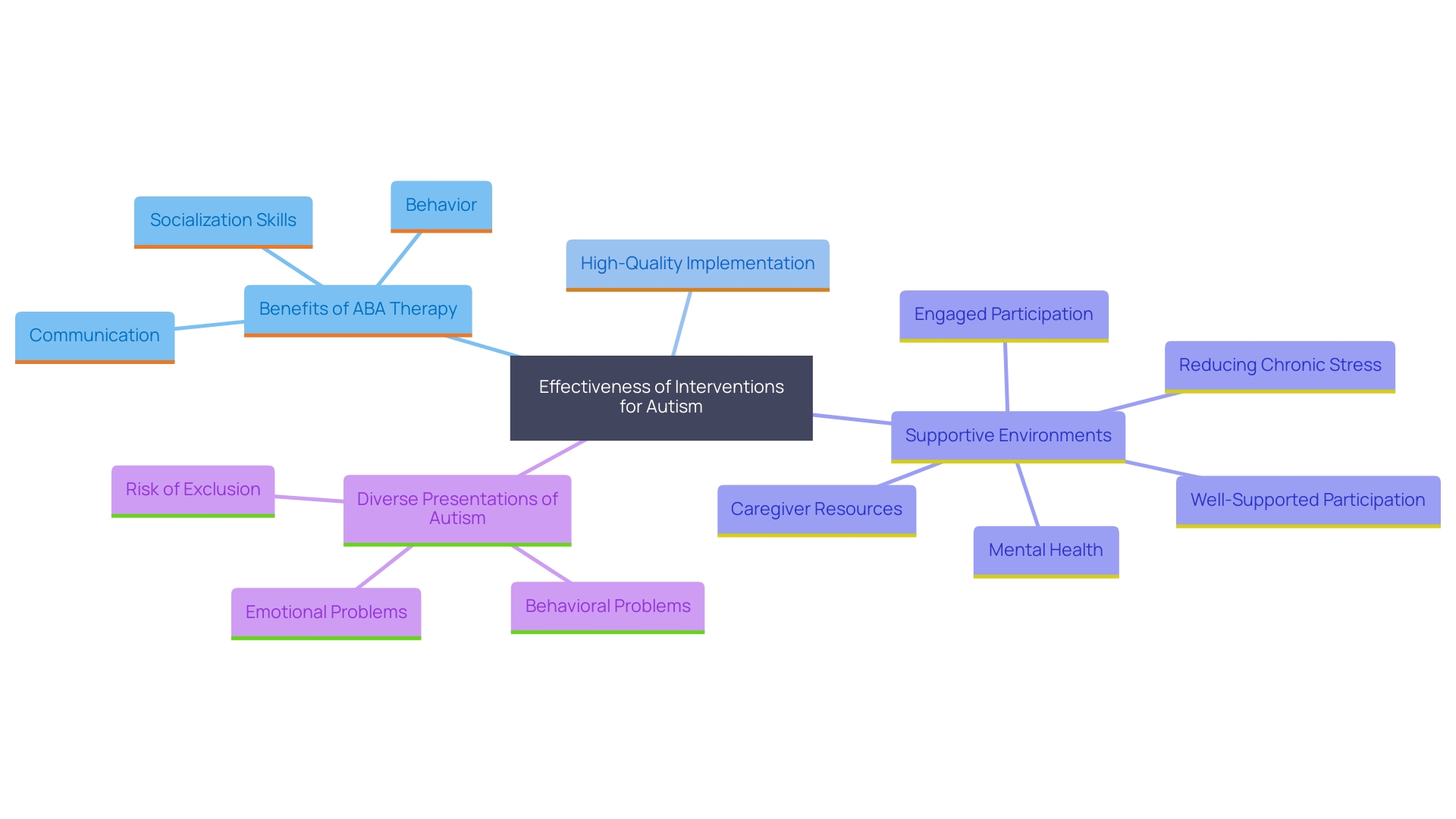Introduction
Navigating the journey of raising a child with autism can be challenging, but understanding the transformative power of Applied Behavior Analysis (ABA) therapy can make a significant difference. ABA therapy stands out as a highly effective approach for supporting children with autism, employing behavioral principles to foster positive changes and skill development. This method breaks down complex tasks into manageable steps, offering a structured and supportive environment where children can thrive.
By addressing each child's unique needs and leveraging their strengths, ABA therapy not only enhances independence but also improves the overall quality of life. Emphasizing the importance of well-supported participation, as highlighted by experts like Dr. David Offord, underscores the significance of equitable support in various life domains for the mental health and development of children with disabilities. This article delves into the key components, benefits, and long-term outcomes of ABA therapy, providing valuable insights and resources to empower parents and caregivers in their advocacy for their children's well-being.
Understanding ABA Therapy for Autism
Applied Behavior Analysis (ABA) therapy is a highly effective approach for supporting individuals with autism. It utilizes concepts of behavior to promote positive changes and development, essential for fostering independence and an improved quality of life. By breaking down complex tasks into manageable steps, ABA provides individuals with a structured and supportive environment to learn critical skills. As Dr. David (Dan) R. Offord emphasized, ensuring that young individuals, including those with disabilities, receive well-supported participation in various life domains is crucial for their mental health and equity. 'This method not only recognizes their unique requirements but also appreciates the contributions they offer to their communities, alleviating chronic stress and equipping caregivers with the essential resources to aid in their offspring's growth.'.

Key Components of ABA Therapy
Applied Behavior Analysis (ABA) therapy is anchored on core components such as comprehensive assessment, customized treatment plans, and meticulous data-driven progress tracking. Initially, each young person undergoes a thorough evaluation to uncover their distinct strengths and challenges, which is pivotal in shaping a personalized treatment plan. This plan aims to enhance specific skills, including communication, social interactions, and daily living skills, ensuring that each individual's unique needs are met. As emphasized by Dr. David (Dan) R. Offord, a well-supported involvement of young individuals with disabilities in various life domains is essential for mental health and equity. By acknowledging both the unmet needs and strengths of autistic individuals, ABA practices aim to offer them the resources essential for their healthy growth and significant social involvement.

Benefits of Early ABA Intervention
Timely intervention is crucial for maximizing the effectiveness of ABA treatment. Studies consistently demonstrate that young individuals who begin treatment early experience significant advancements in behavior and abilities. Timely ABA intervention improves results in communication, social abilities, and academic performance, creating a strong basis for lifelong learning. As Dr. David (Dan) R. Offord once stated, "I do not mind if my offspring are in a race as long as the race is fair." Ensuring that individuals with autism receive timely and effective assistance is a crucial step towards making that race equitable, providing them with the support they need to thrive in their communities and reduce chronic sources of stress for their caregivers.

Skill Development in Autism Therapy Programs
'Autism intervention programs, particularly those directed by Applied Behavior Analysis (ABA) principles, emphasize the comprehensive growth of vital abilities.'. These programs aim to enhance communication, social interactions, and daily living abilities, fostering a supportive environment where young individuals can thrive. Recently updated ABA guidelines underscore the importance of high-quality implementation to achieve optimal outcomes.
Incorporating insights from job-related support, therapists employ tailored strategies to build functional skills that promote independence. For instance, pediatric occupational therapist Kara from Florida emphasizes the significance of encouraging youngsters to perform tasks independently. 'Her experience highlights the positive influence of encouraging independence in youth with autism, aligning with the broader objectives of ABA therapy.'.
Dr. David R. Offord, a renowned psychiatrist specializing in youth, emphasized the importance of fair chances for all young individuals, including those with disabilities. Ensuring that these young individuals have access to well-supported participation in various life domains is crucial for their mental health and overall development. By identifying and responding to their specific requirements, autism support programs play a crucial role in alleviating stress and improving the quality of life for both youngsters and their families.
Social Skills Development in Autism Therapy
Interpersonal abilities are essential in building connections and handling everyday social engagements, particularly for youngsters with autism. ABA therapy plays a crucial role in this by incorporating targeted social skills training. This training instructs young individuals on how to engage effectively with their peers, understand social cues, and build meaningful connections. Through structured role-playing and guided interactions, young individuals learn to communicate more effectively and gain confidence in social settings.
For instance, the case of Lil, a 17-year-old transitioning from a special school to a community-based program, highlights the challenges many autistic individuals face. Programs like Friends of St James Park provide a nurturing atmosphere where young individuals can practice social skills in real-life contexts, such as community clubs and gardening groups, which is essential for their growth.
Moreover, as Dr. David Offord highlighted, ensuring that young individuals, including those with disabilities, engage peacefully and with assistance in their major life areas is vital for their mental health and well-being. Such engagement helps reduce chronic stress and acknowledges the unique assets they bring to their communities.
The importance of these programs is also underscored by the Interagency Autism Coordinating Committee (IACC), which aims to improve coordination and communication across various sectors involved in autism services. By addressing the social and emotional needs of autistic youth, these support programs help create a fairer and more inclusive environment for everyone.
Life Skills Training in Autism Therapy Programs
'Life abilities education is vital in autism treatment initiatives, providing youngsters with necessary competencies for everyday living.'. This training covers various practical areas, including personal hygiene, meal preparation, and time management. By concentrating on these aspects, the treatment not only equips youngsters for increased autonomy but also aids their shift into adulthood. As Dr. David Offord, a renowned psychiatrist specializing in youth, emphasized, “Engaged, peaceful and well-supported participation of youngsters and youth with disabilities in the major school, home, and leisure domains of their lives is a fundamental determinant of mental health.” This holistic approach ensures that individuals with autism can develop the abilities they need to thrive and contribute to their communities, embodying the essence of fair and equitable support for all.
The Role of Positive Reinforcement in ABA Therapy
Positive reinforcement is a cornerstone of Applied Behavior Analysis (ABA) therapy, where rewarding favorable behaviors encourages young individuals to repeat those actions, thereby fostering motivation and engagement. This technique not only bolsters the acquisition of desired skills but also builds self-esteem and nurtures a love for learning. As Doreen Granpeesheh, CEO and founder of the Center for Autism and Related Disorders, emphasizes, establishing a good relationship with both the young person and their family is crucial. Clear communication and active listening are key to ensuring that the therapy is effective and supportive of the entire family's needs. Involving young individuals with disabilities in positive, rewarding activities is crucial for their mental well-being and growth, as highlighted by psychiatrist Dr. David Offord. Ensuring that caregivers have the resources they need to support their offspring's healthy development is fundamental to achieving equity and fostering an inclusive, supportive environment for all.
Evidence-Based Approaches to Autism Therapy
Autism treatment programs prioritize evidence-based practices that are grounded in rigorous research. This approach guarantees that the interventions are not only effective but also customized to the unique requirements of each individual. By utilizing methods that have a track record of yielding positive outcomes, families can be assured of the quality of therapies their young ones receive. As Dr. David (Dan) R. Offord, a renowned psychiatrist for young people, once stated, “Growing up in Canada is like a race.”. I do not mind if my kids are in a race as long as the competition is fair. Ensuring that young people, especially those with disabilities, engage in well-supported and peaceful activities across school, home, and leisure domains is crucial for their mental health and overall well-being. Involving young individuals in such programs not only addresses their needs but also acknowledges the strengths they contribute to their communities, alleviates chronic stress, and fosters their development. This holistic approach aligns with the broader goal of making the 'race' fair for all youngsters, providing parents with the necessary resources to support their offspring’s healthy growth and family well-being.

Long-Term Outcomes of ABA Therapy for Autism
The long-term results of ABA treatment offer substantial promise for children with autism. Studies indicate that many participants in ABA programs experience marked improvements in behavior, communication, and socialization skills as they transition into adulthood. These enhancements often pave the way for better educational and vocational opportunities, significantly boosting their overall quality of life.
The recent release of the third edition of the Applied Behavior Analysis (ABA) Practice Guidelines for the Treatment of Autism Spectrum Disorder by the Council of Autism Service Providers underscores the significance of high-quality, correctly implemented ABA interventions. As Lorri Unumb, CEO of CASP, noted, “ABA is a highly effective treatment for autism. "But it has to be correctly implemented at the highest quality.” This emphasis on proper implementation ensures that young individuals receive the full benefits of the therapy, leading to more positive outcomes.".
Furthermore, the importance of well-supported involvement of young individuals with disabilities in school, home, and leisure activities cannot be overstated. Dr. David (Dan) R. Offord, a renowned psychiatrist for young people, emphasized that a fair and supportive environment is crucial for the mental health and development of all individuals, including those with disabilities. This fair method is crucial for acknowledging both the unmet needs and the strengths that individuals with autism contribute to their communities, allowing them to flourish and mitigate ongoing sources of stress.
In light of the increasing prevalence of autism, with current estimates suggesting that 1 in 36 individuals are diagnosed with the condition, there is a growing understanding of the diverse presentations of autism. This broader perspective helps tailor interventions more effectively, ensuring that individuals with varying abilities receive the support they need to succeed. As Dr. Jan Blacher from UC Riverside points out, recognizing the wide range of abilities within the autism spectrum is key to providing appropriate and effective interventions.
Overall, ABA therapy, when implemented correctly, holds great potential for improving the lives of children with autism, enabling them to achieve their full potential and participate meaningfully in their communities.

Conclusion
The exploration of Applied Behavior Analysis (ABA) therapy reveals its transformative impact on children with autism. By focusing on individualized assessments and tailored treatment plans, ABA therapy not only enhances essential skills but also fosters independence and a higher quality of life. The emphasis on early intervention is particularly crucial, as research shows that timely support leads to significant improvements in communication, social skills, and overall development.
Key components such as positive reinforcement and evidence-based practices are foundational to the success of ABA therapy. These strategies create a nurturing environment where children can thrive and develop vital life skills. The role of caregivers is underscored, as they are provided with resources and support to advocate effectively for their children's needs, ensuring that participation in various life domains is equitable and supportive.
Long-term outcomes of ABA therapy demonstrate promising improvements in behavior, communication, and socialization as children transition into adulthood. The importance of a well-supported and inclusive environment is reiterated, highlighting the need for equitable opportunities for all children, particularly those with disabilities. This holistic approach not only addresses unmet needs but also celebrates the unique strengths that children with autism contribute to their communities.
In summary, ABA therapy stands out as a powerful tool for empowering children with autism and their families. By embracing the principles of ABA, caregivers can navigate the complexities of autism with confidence, ensuring their children receive the support necessary to thrive and participate meaningfully in society.




